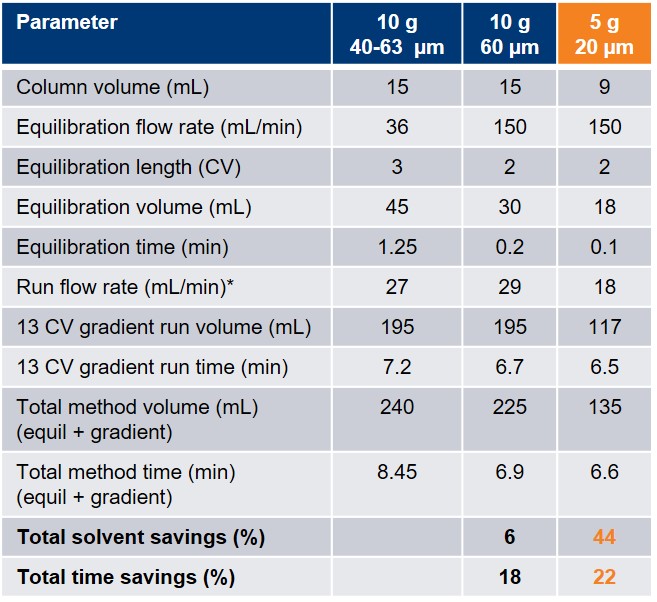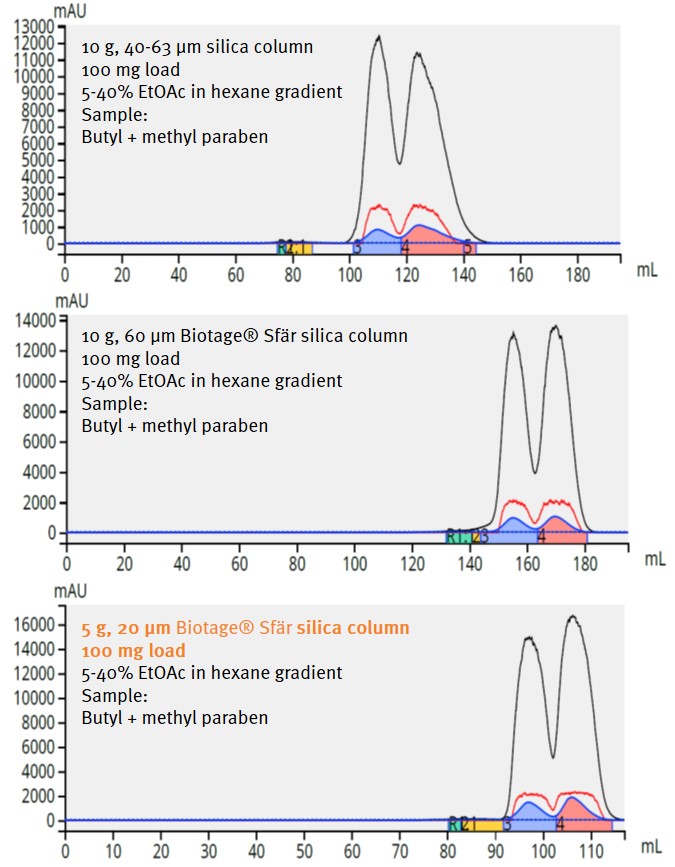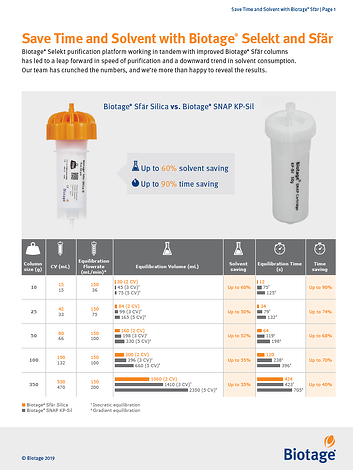When Isolera™ was launched, the maximum system pressure that could be reached was 10 bars, but reaching that pressure was a challenge since most of the Flash columns could not withstand the higher pressures. The maximum pressure rating for the Biotage® SNAP columns, for example, is limited to five or seven bars, depending on the size, and columns from most of manufacturers have the same limitation.
When we decided to replace the SNAP family and introduce the Biotage® Sfär family, we also decided to increase the pressure that they could withstand. With increased pressure tolerance comes the ability to withstand higher flow rates and, as a result, a quicker equilibration process.
In the Biotage® Selekt system, the maximum pressure possible is 32 bar, and the newly developed Sfär columns can be run at between 12 or 20 bar, depending on size.
It is widely known that using higher flow rates during column equilibration provides more efficient wetting of the Silica. The increased equilibration flow rates generate higher pressure which forces solvent into the media's pores and displacing the entrapped air. As a result, less solvent and less time might be needed to fully equilibrate the column. Provided that the columns can actually stand the pressure.
To show the benefits provided using increased equilibration flow/pressure, we compared the combination of Isolera and SNAP columns (with their flowrate and pressure limitations) against the Selekt with Sfär team, that can run with a higher flow flowrate and at a higher pressure, Table 1. Check it out here: The results speak for themselves!
Table 1. Equilibration time and solvent savings comparison.
In the Isolera system, two equilibration methods were used:
3 CV’s for isocratic equilibration when the amount of the polar solvent (B) was below 10 %, or
a 5 CV long gradient equilibration method, when the amount of the polar solvent (B) exceeded 10 %.
The reason for the two different equilibration methods was due to the fact that the Isolera system could not handle the heat generated during the initial solvation of the Silica bed.
With the Selekt system we designed a novel, "pressure-based" equilibration protocol which is used with the Sfär columns thus enabling faster equilibration. This new equilibration method also reduces the required volume for sufficient wetting.
Solvent and time savings are also realized with actual purification runs. Using the Selekt system, three columns were used (SNAP KP-Sil (10 grams), Sfär 60 µm (10 grams), and Sfär 20 µm (5 grams)) to purify a 2-component mix with the same load (100 mg), solvents, and gradient. Each column's default equilibration flow rate and column volume were used. For the purification run, flow rates were adjusted to ensure equivalent linear velocity.
The realized solvent savings between the 10 gram KP-Sil and 10-gram Sfär 60 µm for the purification was 6% and time savings was 18%. A larger savings in solvent (44%) and time (22%) was achieved when a 5-gram, 20 µm Sfär column is used to purify the same 100 mg sample load, Table 2.
Table. 2 Full purification run solvent and time savings

All this savings without separation performance degradation, Figure 1.

Figure 1. Chromatographic comparison of three columns for the purification of a 2-component mix (100 mg load) shows improved solvent savings with a smaller, high performance column.
While speed is not everything, speed combined with solvent savings, excellent separation performance, and increased safety is definitely a step in the right direction.

 Organic Workflow
Organic Workflow Peptide Workflow
Peptide Workflow Scale-Up Flash Purification
Scale-Up Flash Purification  Sample Preparation
Sample Preparation Biomolecule Purification
Biomolecule Purification Oligo synthesis
Oligo synthesis Scavengers and Reagents
Scavengers and Reagents Service & Support
Service & Support Accessories & Spare parts
Accessories & Spare parts Investors
Investors Reports & News
Reports & News The Share
The Share Corporate Governance
Corporate Governance Calendar
Calendar Sustainability
Sustainability Our Offering
Our Offering Our History
Our History Our Locations
Our Locations Leadership
Leadership
